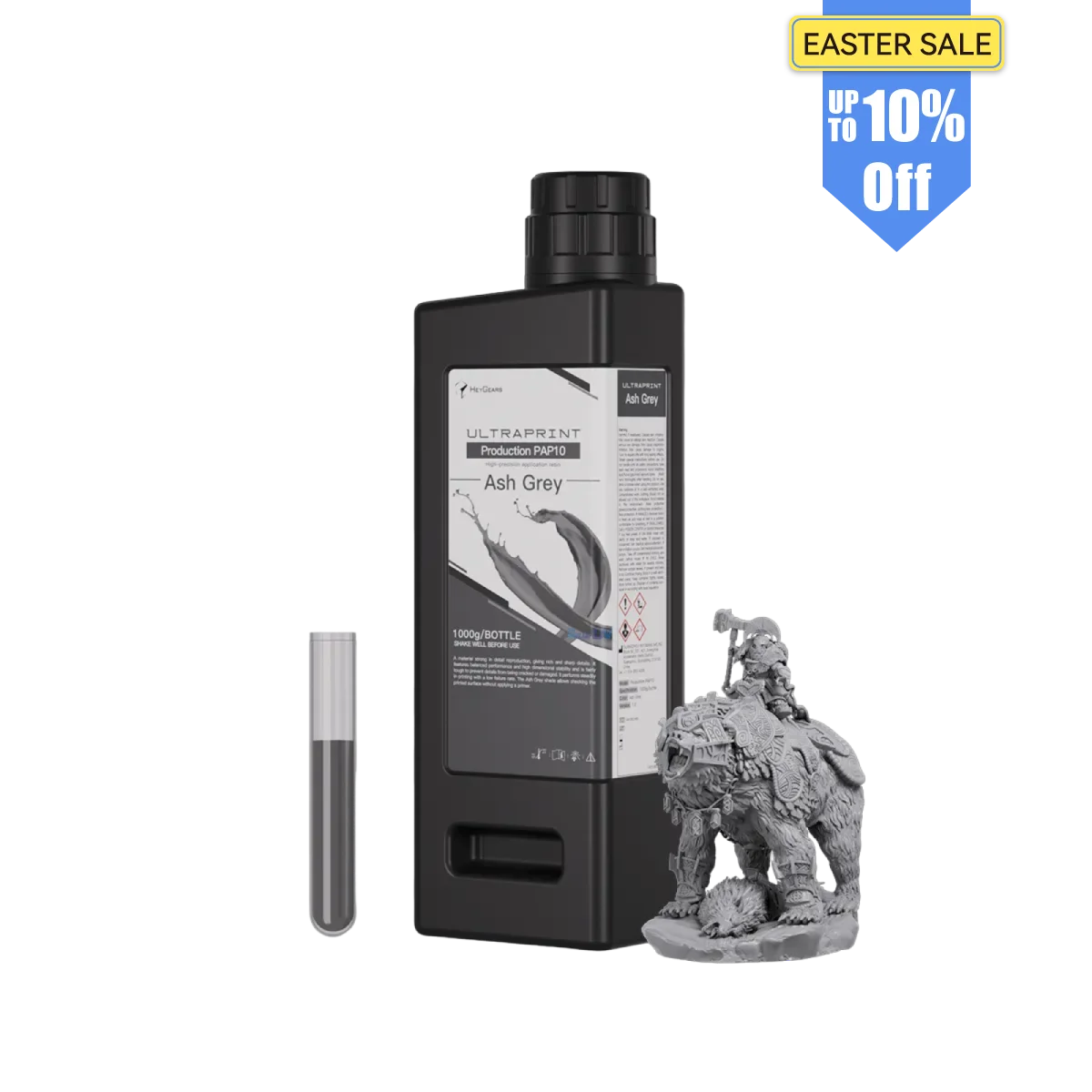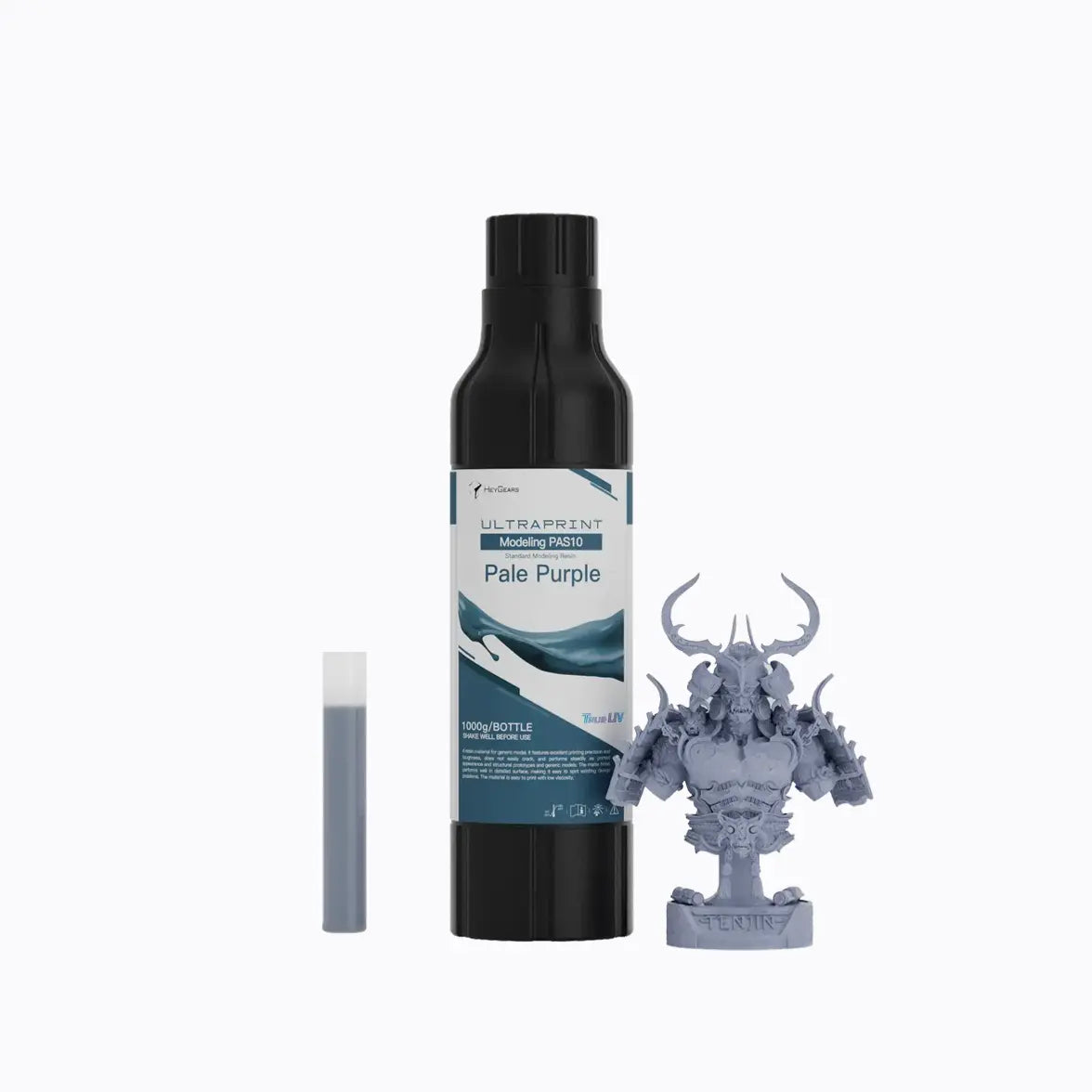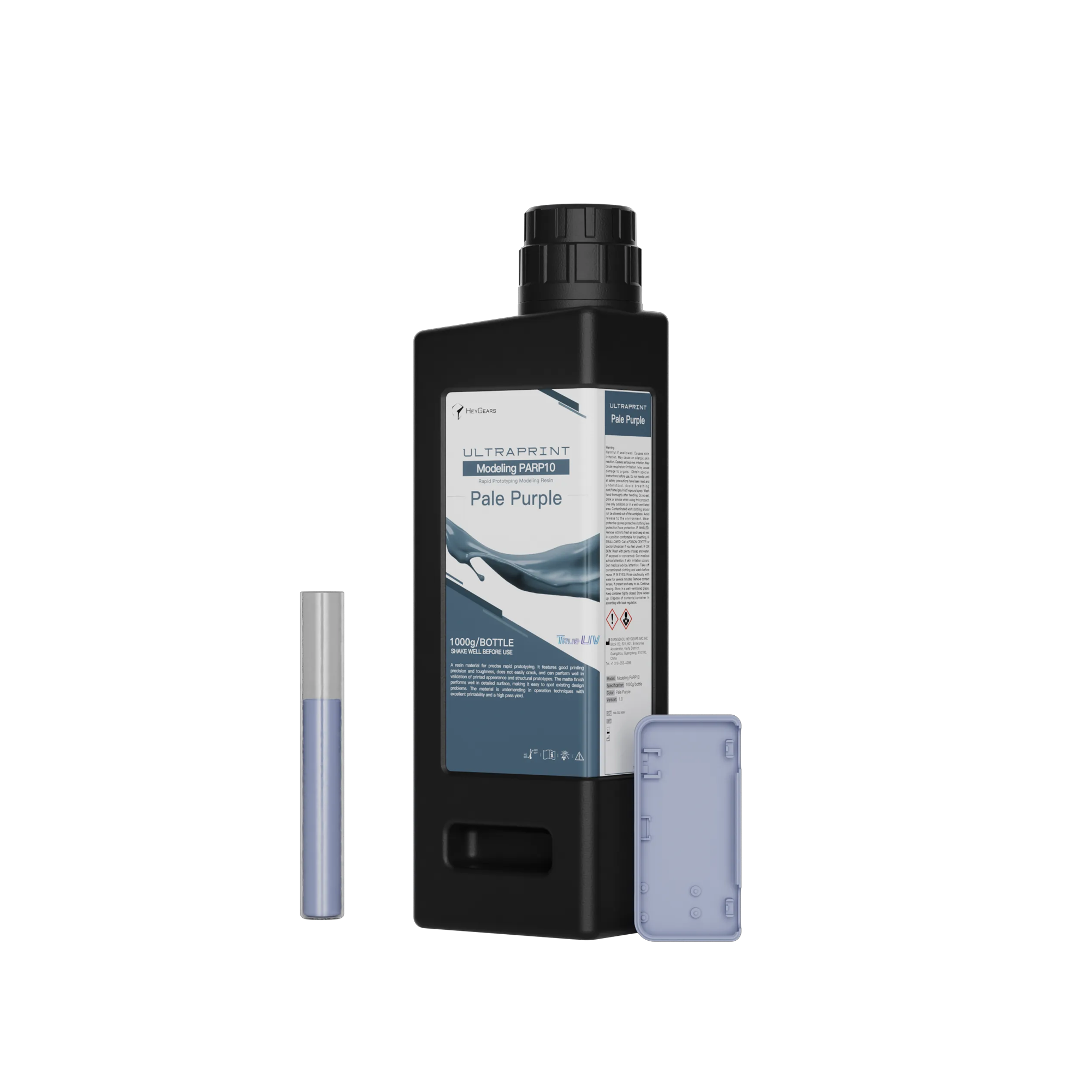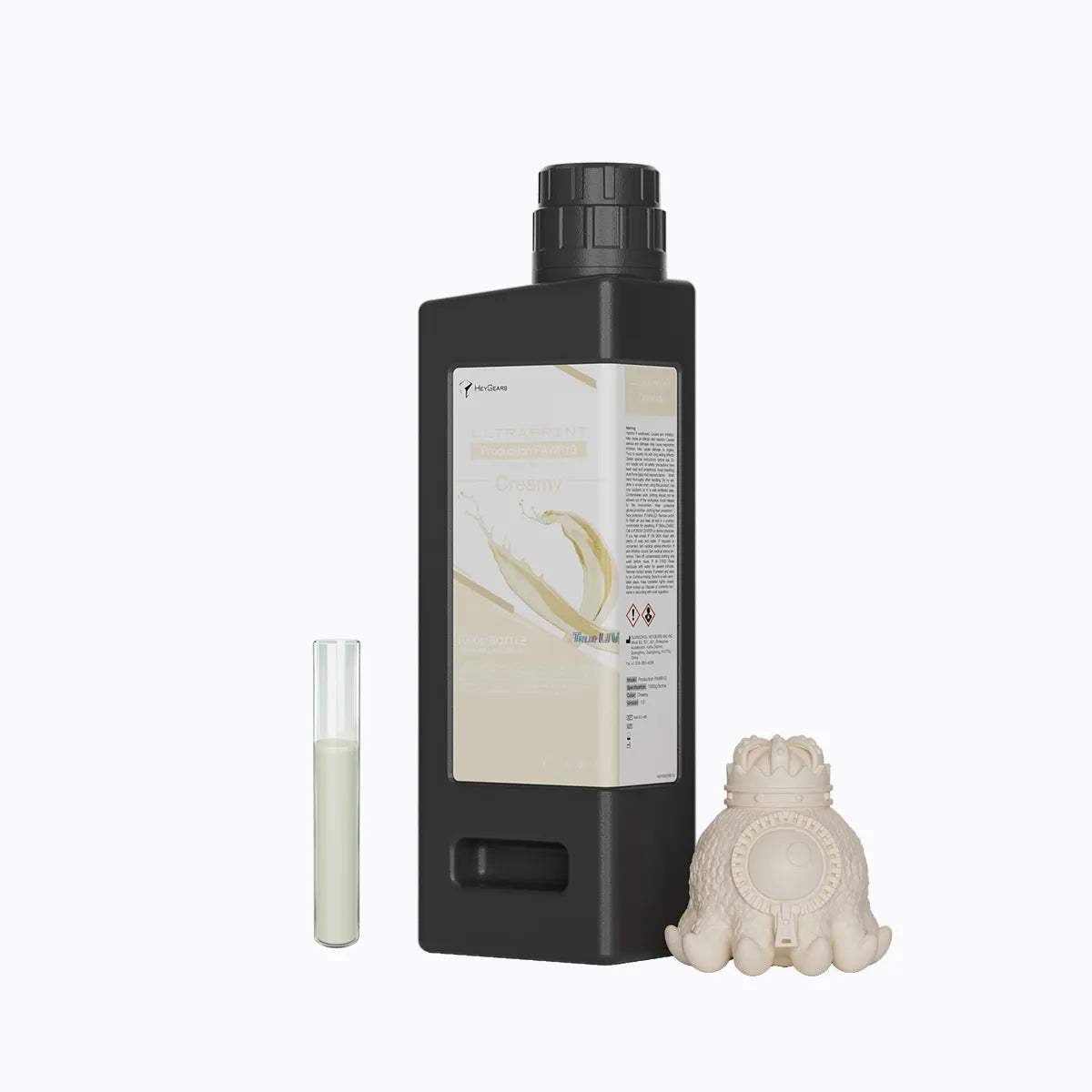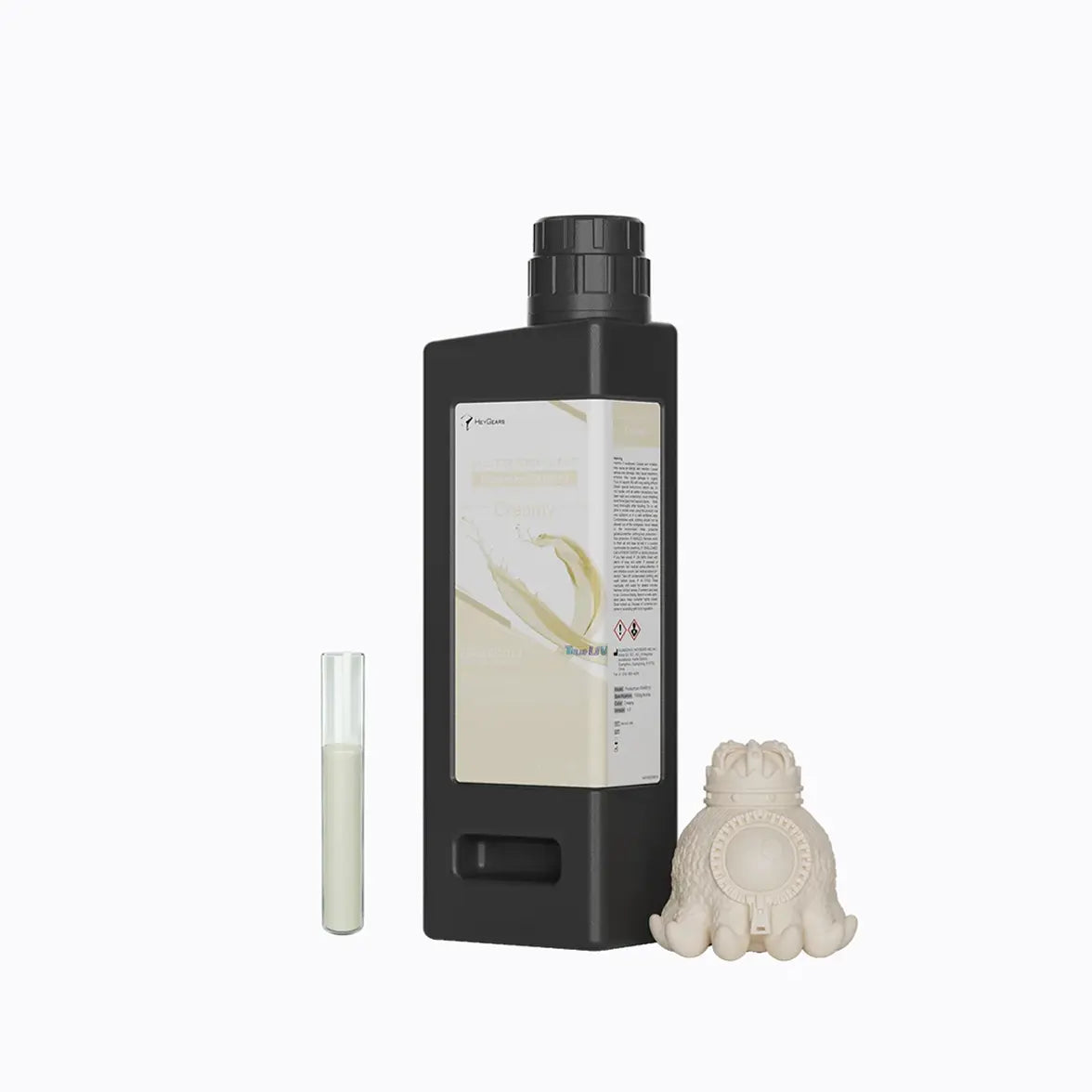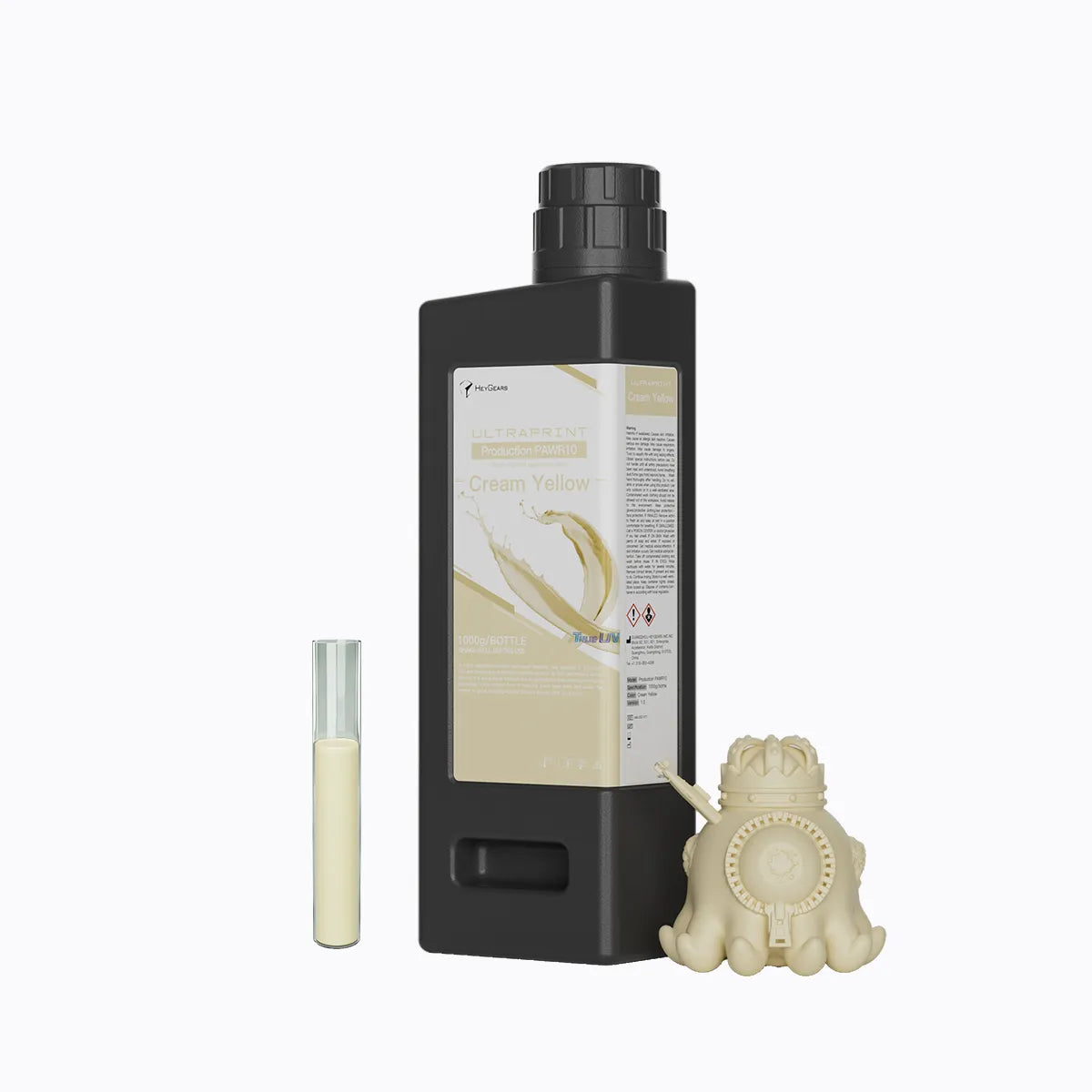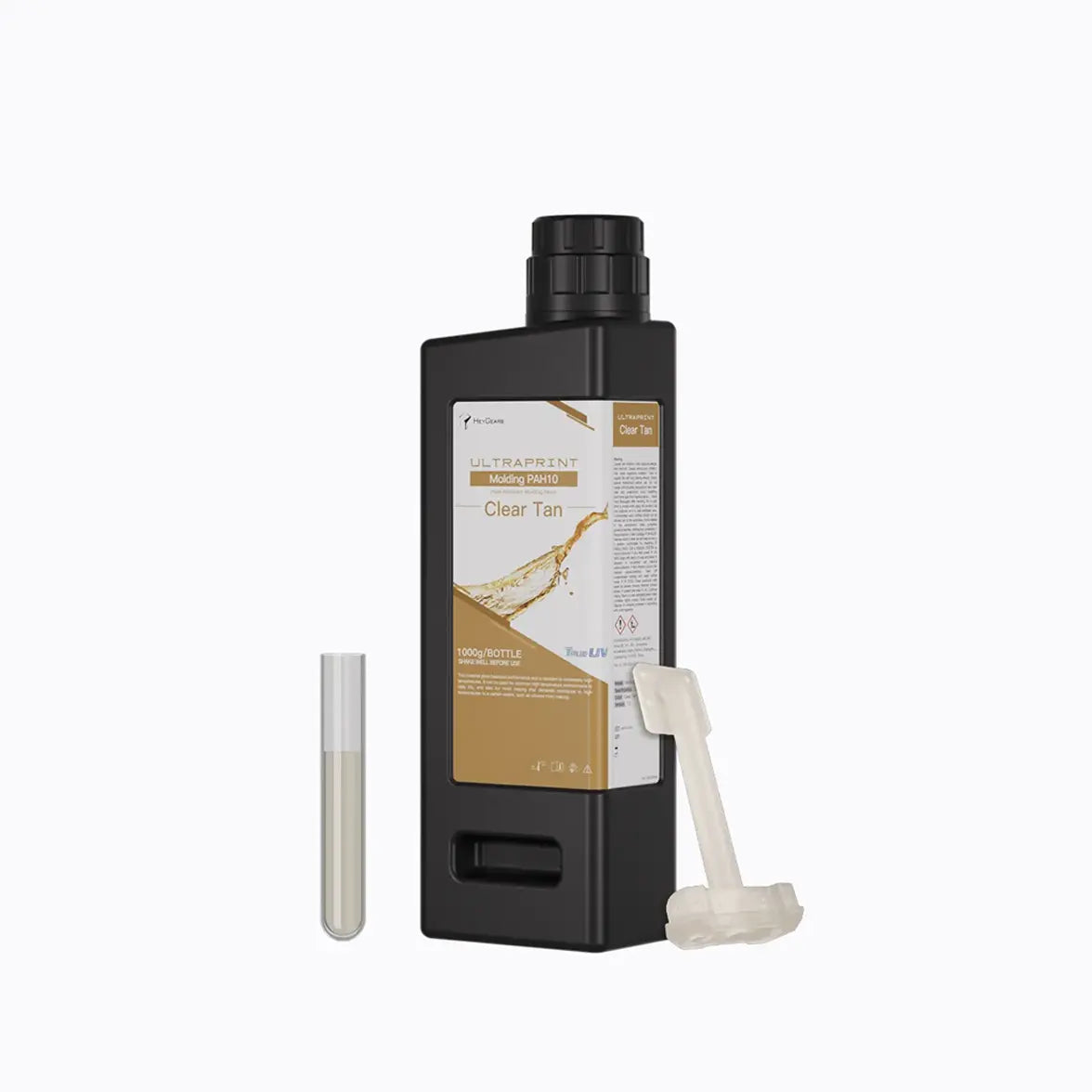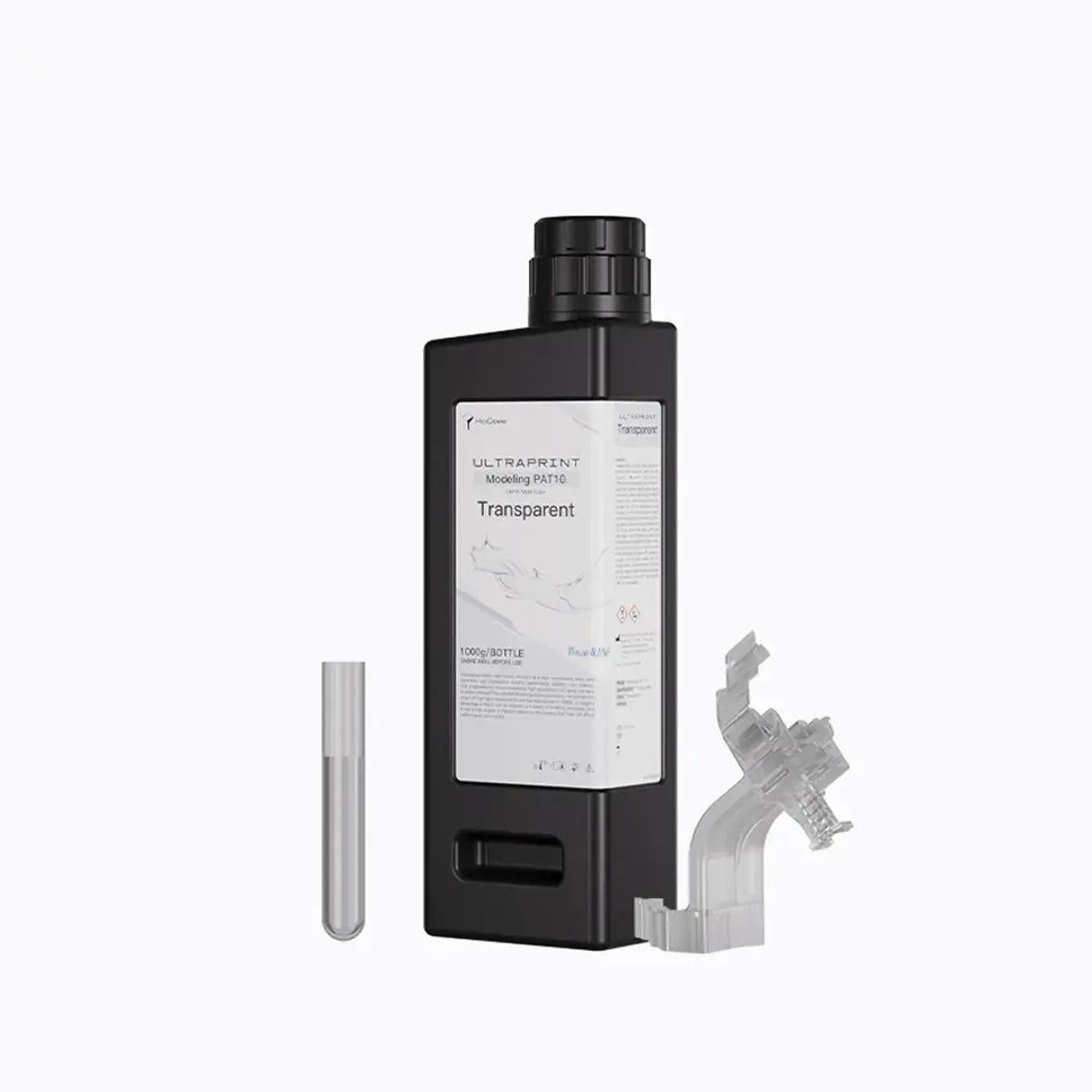UltraPrint-Production PAP10 Precise Detail Resin
UltraPrint-Modeling PAWW10 Water Washable Resin
UltraPrint-Modeling PAWW20 Water Washable Modeling Resin

New HeyGears 3D Printers
Precision Matched with Speed
UltraPrint Production PAF10 Flexible Production Resin (PVC-like)
UltraPrint-Production PAP10 Precise Detail Resin
UltraPrint-Modeling PAWW10 Water Washable Resin
UltraPrint-Modeling PAWW20 Water Washable Modeling Resin
UltraPrint-Modeling PAS10 Standard Modeling Resin
UltraPrint-Modeling PARP10 Rapid Prototyping Modeling Resin (Pale Purple)
UltraPrint-Production PAWR10 Wear-Resistant Resin
UltraPrint-Molding PAH10 High-Temperature Resistance Resin
UltraPrint-Modeling PAU10 ABS-like Resin
UltraPrint-Modeling PAT10 Transparent Resin
UltraPrint-Casting PAC10 Wax Casting Resin
FAQs
What are the pros and cons of 3D printer resin?
Pros of 3D Printer Resin:
- High Detail and Smooth Surface Finish: Resin materials are capable of producing extremely fine details and smooth surfaces, making them perfect for intricate models, jewelry, and dental applications.
- Wide Variety of Formulations: Resins come in specialized types, such as standard, tough, flexible, high-temperature resistant, and biocompatible, allowing users to select the best material for their specific project needs.
- Excellent Aesthetic Quality: Resin prints often have a polished, professional look with minimal visible layer lines, making them ideal for display pieces or prototypes.
- Fast Curing Process: Resin cures rapidly under UV light—entire layers are hardened simultaneously in LCD and DLP printers. In contrast, materials used in FDM printing (like PLA or ABS) require the nozzle to trace each layer, which is generally slower.
- Versatility in Applications: 3D printer resins are used across industries, including healthcare (biocompatible resins), engineering (tough resins), and art (high-detail resins), due to their adaptability and performance.
Cons of 3D Printer Resin:
- Messy and Time-Consuming Post-Processing: Resin prints require washing in isopropyl alcohol (IPA) or other cleaning solutions and curing under UV light, which adds extra steps to the workflow.
- Toxicity and Safety Concerns: 3D printing resin is toxic and can irritate the skin and eyes. Proper safety precautions, such as gloves, goggles, and ventilation, are essential.
- Higher Material Cost: Resin is generally more expensive than filament, and the process requires additional materials like IPA and UV lamps, increasing overall costs.
- Limited Durability for Some Types: Standard resins can be brittle and less durable compared to filament-based prints, though specialty resins like tough or ABS-like resins address this issue.
- Shelf Life and Storage Requirements: UV curing resin has a limited shelf life and must be stored properly to prevent degradation.
What is the resin for 3D printing?
Resin for 3D printing is a liquid photopolymer and 3D printer printing material that hardens when exposed to specific wavelengths of light, typically UV light. Some of them are also known as UV resin or ultraviolet resin. It is used in SLA (Stereolithography), DLP (Digital Light Processing), and LCD-based 3D resin printers. UV cure resin formulations come in various types tailored for different applications, such as standard, tough, flexible, high-detail, or biocompatible uses, each designed to offer superior performance when exposed to ultraviolet curing resin.
Is resin 3D printing cheaper than filament?
Resin 3D printing is generally more expensive than filament-based (FDM) printing.
The cost of UVresinitself is higher than filament, and the process requires additional materials like isopropyl alcohol for cleaning and UV lamps for curing.
What types of 3D printing resins are available for 3D printers in HeyGears?
HeyGears offers a wide variety of UV resins, each designed to meet specific needs and applications. Here are the types of 3D printing resins available at HeyGears:
- Standard Modeling Resin - PAS10/PARP10 (Pale Purple/Orange Clay)
It has ±0.05 mm printed part tolerance, good detail sharpness, and a matte surface with near-invisible layer lines, applied in scale replicas, figurines & statues, and jewelry design prototyping.
- Transparent Resin - PAT10
With 88.5% light transmittance, 13200 J/m² work of fracture, and anti-yellowing properties lasting 8 years indoors, it applies to models/accessories needing transparent or translucent effects, casings for electronic products, and earphone casings (end-use).
- ABS-like Resin - PAU10
Boasting high fracture toughness (8240 J/m² work of fracture), it is suitable for industrial fixtures, casings for consumer electronics and tooling products, as well as functional prototypes validating ABS-like properties.
- Water Washable Resin - PAWW10
With 2.9% water sorption for long-term use, 3-minute water washability, and fast print speed, it fits rapid prototypes, models, and figurines & statues.
- Water Washable Resin - PAWW20
Easy to print and post-process, with good toughness and drill/tap readiness in 1 month, it is used for concept prototypes like industrial parts, figurines, and accessories.
- Wax Casting Resin - PAC10
Containing 70–75% wax content and 0.02% ash value for clear burnout, it is designed for lost-wax casting of lightweight structures (rings, earrings, pendants), finely detailed structures (studs, mesh-like accessories), and heavyweight structures (bracelets, bulky rings).
- Polycarbonate-like Tooling Resin - PAU20
With high rigidity (2300 MPa flexural modulus) and resistance to deformation/fracture (5400 J/m² work of fracture), it applies to industrial fixtures & jigs (for long-term use), end-use structural components (brackets, camera mounts, protective casings), and shell parts resisting deformation.
- Silicone-like Elastic Tool Resin - PAE10
Offering excellent elasticity (433% elongation at break), rapid rebound, and 83% energy recovery rate, it is suitable for models & accessories (clothing, ornaments), and industrial component prototypes (sealing plugs, fixtures).
- High Precise Detail Resin - PAP10
With excellent printability (0.1 mm smallest pillar diameter) and high fracture toughness (2370 J/m² work of fracture), it fits tabletop miniatures (end-use), scale replicas, and models with finely textured surfaces.
- Durable Resin - PAWR10
Featuring 2H high surface hardness, wear resistance, and a smooth surface with near-invisible layer lines, it applies to BJD, articulated action figures, consumer electronics, home appliance shell parts, car interior prototypes, and products needing repeated wearing or bending.
- Flexible 3D Printing Resin - PAF10
Resistant to damage from repeated bending (46% elongation at break) and with 1.6% water sorption for long-term use, it is suitable for tabletop miniatures, scale replicas, figurines & accessories, and flexible structural prototypes (keycaps, buttons, squeeze bottles, car interior parts).
- High Temperature Resin - PAH10
With high-temperature resistance (110℃/230℉ heat deflection temperature at 0.455 MPa) and high rigidity (3260 MPa flexural modulus), it is used for silicone molds and high-temperature-resistant prototypes.
What is the difference between standard and specialty 3D printer resins?
Standard resins are designed for general-purpose use, offering a good balance of strength, detail, and surface finish. They are suitable for a wide range of applications, from prototypes to decorative items.
Specialty resins, on the other hand, are formulated for specific purposes. For example, tough resins are engineered for durability, flexible resins for elasticity, and biocompatible resins for medical applications.
How do I choose the right resin for a 3D printer project?
Choosing the right resin for your 3D printing project requires careful consideration of several factors. Start by thinking about the purpose of your print.
If you’re creating decorative items like miniatures or art pieces, resins that offer high detail and a smooth surface finish, such as high-detail or transparent resins, are ideal. On the other hand, if you’re printing functional parts that need to endure stress or mechanical loads, tough or ABS-like resins are better choices due to their durability and flexibility.
Next, consider the mechanical properties you need. For strong, long-lasting parts, resins like tough or high-temperature-resistant resins are excellent options. If your project requires parts that can bend or compress, such as gaskets or hinges, elastic resin is the way to go. These ultraviolet resinsare specifically formulated to provide the flexibility and elasticity needed for such applications.
Another important factor is post-processing requirements. Some ultraviolet curing resins, like water-washable resins, simplify cleaning by eliminating the need for isopropyl alcohol (IPA), making them more user-friendly. If you want to minimize post-processing steps, look for resins that cure quickly and cleanly, saving you time and effort.
The environmental conditions your print will be exposed to also play a role in resin selection. For parts that will face high temperatures, high-temperature-resistant resins are essential. If your project involves outdoor use or exposure to chemicals, ensure the resin has UV and chemical resistance to maintain its integrity over time.
For projects requiring high levels of detail, such as jewelry, dental models, or intricate designs, high-precise resins or wax casting resins are the best options. These resins are engineered to capture fine details and produce smooth, professional-quality prints.
Finally, if your project involves safety or biocompatibility concerns, such as medical or dental applications, choose resins that are specifically certified as biocompatible. These resins are safe for contact with skin or internal use, ensuring they meet the necessary health and safety standards.
What safety precautions should I take when handling 3D printer resin?
Ultravioletresincan be toxic and should be handled with care. Always wear nitrile gloves and safety goggles to avoid skin contact and eye irritation. Work in a well-ventilated area or use a respirator to avoid inhaling fumes. Clean up spills immediately with isopropyl alcohol and dispose of waste resin properly.
Can I mix different types of 3D printing resins?
Mixing printer 3d resins is generally not recommended unless specified by the manufacturer. Different ultraviolet resins have unique chemical compositions, and mixing them can lead to unpredictable results, such as improper curing or weakened mechanical properties.
How do I clean and maintain my HeyGears resin 3D printer after using ultraviolet curing resin?
Maintaining your HeyGears Reflex resin 3D printer after printing with UV-curable resin is essential to ensure long-term performance and consistent print quality.
Here's the cleaning and maintenance checklist for HeyGears 3D resin printers:
After Each Print:
- Resin Tray Cleaning: Use the provided scraper card to remove any leftover resin. Then wipe the tray with a clean cloth and 95% alcohol until no dust, fingerprints, or stains remain. Use a light to inspect the tray and check if the release film is damaged—replace it if necessary.
- Build Platform Cleaning: Remove the printed parts and check for any residue. Clean with alcohol and a cotton stick if needed.
- Operational Surface Cleaning: Wipe any resin spills on the machine’s surface using a soft cloth and alcohol.
- General Check: Make sure no foreign objects are left in the positioning holes or beneath the resin bottle.
Irregular Maintenance (As Needed):
- Whole Machine Cleaning: Use a cloth with alcohol to wipe down all outer surfaces.
- Platform Deep Cleaning: Place the platform in the washing unit with alcohol, run a 2-minute wash cycle, then dry it with an air gun.
- LCD Screen Cleaning: Spray alcohol on a soft cloth and gently wipe the screen in one direction. Use a light to check for remaining stains or damage.
Weekly Maintenance:
- Sensor & Port Check: Inspect the temperature sensor, resin level detector, and bottle insertion port for resin residue. Clean if necessary.
Monthly Maintenance:
- LCD Screen Condition: Use a clean sheet of paper and the “Clean Raw Material” function to check for black spots or damage on the anti-scratch film. Replace if needed.
- Screen Tape Check: Ensure there are no light leaks in the taped area covering the screen frame.
What are the overall performance advantages and application areas of Production PAP10 high-detail application resin?
Production PAP10 is a high-performance resin designed for fine-detail applications. It offers a unique balance of high strength, moderate toughness, and heat resistance, making it suitable for demanding use cases. The material also excels in:
- High-resolution detail reproduction, ideal for small and intricate features.
- Excellent dimensional, performance, and color stability.
- Good aging resistance, validated through multiple industry-standard accelerated aging tests.
Typical application areas include:
- End-use miniature products in fields such as character figures, creatures, props, and terrains.
- Scale model scenes require detailed and accurate surface reproduction.
- Texture-rich designs, where highlighting fine surface features is essential.







